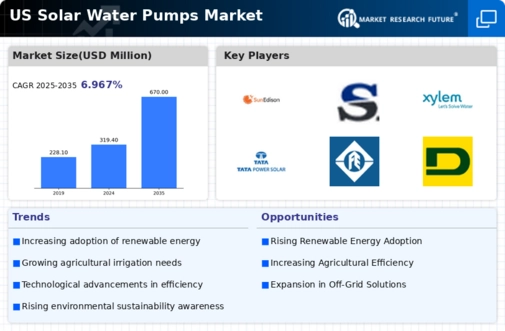Increasing Energy Costs
The rising costs of conventional energy sources are driving the solar water-pumps market. As energy prices continue to escalate, agricultural and industrial sectors are seeking cost-effective alternatives. Solar water-pumps offer a sustainable solution, reducing reliance on grid electricity and fossil fuels. In the US, energy costs have surged by approximately 15% over the past five years, prompting businesses to explore renewable energy options. This trend is likely to enhance the adoption of solar water-pumps, as they provide long-term savings and energy independence. The solar water-pumps market is thus positioned to benefit from this shift towards renewable energy, as more users recognize the financial advantages of solar technology in mitigating energy expenses.
Rural Electrification Programs
Rural electrification initiatives are playing a crucial role in expanding the solar water-pumps market. Many rural areas in the US still lack reliable access to electricity, which hampers agricultural productivity and economic development. Solar water-pumps present a viable solution for these regions, providing a sustainable source of water for irrigation without the need for extensive electrical infrastructure. Government and non-profit organizations are increasingly investing in solar projects to enhance rural livelihoods. This focus on electrification is expected to boost the solar water-pumps market, as more rural communities adopt solar technology to improve their agricultural practices and overall quality of life.
Environmental Sustainability Initiatives
Growing awareness of environmental issues is propelling the solar water-pumps market. As climate change concerns intensify, there is a collective push towards sustainable practices across various sectors. The agricultural industry, in particular, is under pressure to adopt eco-friendly technologies. Solar water-pumps align with these sustainability goals by reducing carbon footprints and conserving water resources. In the US, initiatives aimed at promoting sustainable agriculture have gained traction, with many farmers transitioning to renewable energy solutions. This shift not only supports environmental objectives but also enhances the market for solar water-pumps, as stakeholders seek to comply with regulations and consumer preferences favoring sustainable products.
Technological Innovations in Solar Solutions
Advancements in solar technology are significantly impacting the solar water-pumps market. Innovations such as improved photovoltaic cells and energy storage systems are enhancing the efficiency and reliability of solar water-pumps. These developments enable users to harness solar energy more effectively, even in less sunny regions. The introduction of smart irrigation systems, which integrate solar water-pumps with IoT technology, is also gaining traction. In the US, the market for smart irrigation is projected to grow by 20% annually, indicating a strong demand for technologically advanced solutions. As these innovations continue to emerge, they are likely to drive the adoption of solar water-pumps, making them more appealing to a broader range of users.
Growing Demand for Water Management Solutions
The increasing demand for efficient water management is a significant driver of the solar water-pumps market. With water scarcity becoming a pressing issue in many regions, particularly in agriculture, there is a heightened need for effective irrigation solutions. Solar water-pumps offer a reliable and sustainable method for water extraction and distribution, addressing the challenges posed by traditional pumping systems. In the US, the agricultural sector is projected to see a 10% increase in the adoption of water-efficient technologies over the next five years. This trend indicates a growing recognition of the importance of sustainable water management, positioning solar water-pumps as a key player in meeting these demands.






















Leave a Comment